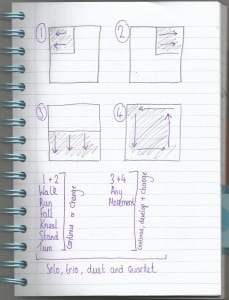Part 1
Continue. Develop. Change. Develop, develop, develop. I always come back to develop.
Whilst moving through space I became aware that my movement was dominated by development, my movement would develop in various forms: spatial pathways, levels and dynamics. When being observed, my partner came to the same conclusions as I did. It seems that developing movement is habitual to me.
Establish. Change. Establish. Change. This is definitely not habitual to me.
Establish movement content.
Change, when your partner shouts the word.
Establish a new movement.
Through this process I became very reactive to the change, I became aware of an eagerness within me to find the next new thing. I had quickly exhausted my habitual movement, and what came after seemed unnatural, even weird and silly. I found myself creating movement I had never experienced before. The observer even noted that the movement became more interesting to watch.
Attention, establish. Change. Attention, establish. Change. I don’t want to change.
Now with the same process, we had to incorporate attention; ‘an intentional focus on a specific “thing”, or closely observing the relationship and interaction of more than one “thing”. (De Spain, 2014)
Naturally, the movement quality of this process became slow and sustained. To adhere to this process, I focused my attention in one part of the body, and worked my movement around the attention. I found in myself an unwillingness to change, I had become attached to my movement and the feeling of it. My sole attention was focused in that one place. I became attached to how the movement felt. From this I developed an intention. I intended to find movement that felt the same or had a connection to the previous. I left myself ‘not open to the magic of the unexpected’ (De Spain, 2014, 69) I created a limitation that left little room for the new.
Part 2. The score. The Jam.
Section 1 –
I thought that only being able to use the six movement list above, that this section would be repetitive. It was interesting to see how different formations were conceived within the space and with what movement. This is what struck me most. It seems that there are infinite number of possibilities.
Section 2 –
It is interesting how section 1 and 2 appeared and felt completely different, and the only thing that changed was the spatial orientation.
Section 3 –
It became difficult to break away from the six limitations of movement, we could now perform anything but I felt comfortable with the previous. It took sometime before I could comfortably initiate movement, as opposed to continuing or developing.
Section 4 –
I found my feet in this section. Maybe because it was similar to section 3, a side from the increase of space we could perform in. I could apply the ideas of tracking, attention and intention to movement.
I track the essence of movement.
I pay attention to a particular body part of a movement.
I intend to continue, develop or change.
De Spain, K. (2014) Landscape of the Now. New York: Oxford University Press.
